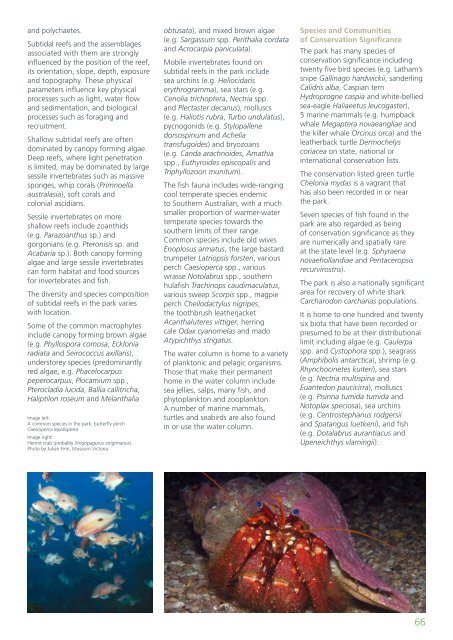Marine Natural Values Study Summary - Parks Victoria
Marine Natural Values Study Summary - Parks Victoria
Marine Natural Values Study Summary - Parks Victoria
Create successful ePaper yourself
Turn your PDF publications into a flip-book with our unique Google optimized e-Paper software.
and polychaetes.Subtidal reefs and the assemblagesassociated with them are stronglyinfluenced by the position of the reef,its orientation, slope, depth, exposureand topography. These physicalparameters influence key physicalprocesses such as light, water flowand sedimentation, and biologicalprocesses such as foraging andrecruitment.Shallow subtidal reefs are oftendominated by canopy forming algae.Deep reefs, where light penetrationis limited, may be dominated by largesessile invertebrates such as massivesponges, whip corals (Primnoellaaustralasia), soft corals andcolonial ascidians.Sessile invertebrates on moreshallow reefs include zoanthids(e.g. Parazoanthus sp.) andgorgonians (e.g. Pteronisis sp. andAcabaria sp.). Both canopy formingalgae and large sessile invertebratescan form habitat and food sourcesfor invertebrates and fish.The diversity and species compositionof subtidal reefs in the park varieswith location.Some of the common macrophytesinclude canopy forming brown algae(e.g. Phyllospora comosa, Eckloniaradiata and Seirococcus axillaris),understorey species (predominantlyred algae, e.g. Phacelocarpuspeperocarpus, Plocamium spp.,Pterocladia lucida, Ballia callitricha,Haliptilon roseum and MelanthaliaImage left:A common species in the park: butterfly perchCaesioperca lepidoptera.Image right:Hermit crab (probably Strigopagurus strigimanus).Photo by Julian Finn, Museum <strong>Victoria</strong>.obtusata), and mixed brown algae(e.g. Sargassum spp. Perithalia cordataand Acrocarpia paniculata).Mobile invertebrates found onsubtidal reefs in the park includesea urchins (e.g. Heliocidariserythrogramma), sea stars (e.g.Cenolia trichoptera, Nectria spp.and Plectaster decanus), molluscs(e.g. Haliotis rubra, Turbo undulatus),pycnogonids (e.g. Stylopallenedorsospinum and Acheliatransfugoides) and bryozoans(e.g. Canda arachnoides, Amathiaspp., Euthyroides episcopalis andTriphyllozoon munitum).The fish fauna includes wide-rangingcool temperate species endemicto Southern Australian, with a muchsmaller proportion of warmer-watertemperate species towards thesouthern limits of their range.Common species include old wivesEnoplosus armatus, the large bastardtrumpeter Latriopsis forsteri, variousperch Caesioperca spp., variouswrasse Notolabrus spp., southernhulafish Trachinops caudimaculatus,various sweep Scorpis spp., magpieperch Cheilodactylus nigripes,the toothbrush leatherjacketAcanthaluteres vittiger, herringcale Odax cyanomelas and madoAtypichthys strigatus.The water column is home to a varietyof planktonic and pelagic organisms.Those that make their permanenthome in the water column includesea jellies, salps, many fish, andphytoplankton and zooplankton.A number of marine mammals,turtles and seabirds are also foundin or use the water column.Species and Communitiesof Conservation SignificanceThe park has many species ofconservation significance includingtwenty five bird species (e.g. Latham’ssnipe Gallinago hardwickii, sanderlingCalidris alba, Caspian ternHydroprogne caspia and white-belliedsea-eagle Haliaeetus leucogaster),5 marine mammals (e.g. humpbackwhale Megaptera novaeangliae andthe killer whale Orcinus orca) and theleatherback turtle Dermochelyscoriacea on state, national orinternational conservation lists.The conservation listed green turtleChelonia mydas is a vagrant thathas also been recorded in or nearthe park.Seven species of fish found in thepark are also regarded as beingof conservation significance as theyare numerically and spatially rareat the state level (e.g. Sphyraenanovaehollandiae and Pentaceropsisrecurvirostris).The park is also a nationally significantarea for recovery of white sharkCarcharodon carcharias populations.It is home to one hundred and twentysix biota that have been recorded orpresumed to be at their distributionallimit including algae (e.g. Caulerpaspp. and Cystophora spp.), seagrass(Amphibolis antarctica), shrimp (e.g.Rhynchocinetes kuiteri), sea stars(e.g. Nectria multispina andEuantedon paucicirra), molluscs(e.g. Pisinna tumida tumida andNotoplax speciosa), sea urchins(e.g. Centrostephanus rodgersiiand Spatangus luetkeni), and fish(e.g. Dotalabrus aurantiacus andUpeneichthys vlamingii).66
















